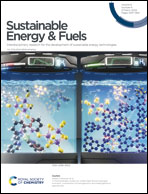The effect of electrolyte with binary solvents on improving the performance of rechargeable lithium–oxygen batteries†
Abstract
The lithium–oxygen battery has received significant attention due to its potential for promoting clean energy, thanks to its ultrahigh theoretical energy density. One of the critical remaining obstacles is seeking an electrolyte that has ample physicochemical and electrochemical tolerance in a semi-open cell operating environment. This paper provides a detailed discussion from the perspective of electrolyte selection, explaining how binary solvents affect product morphology and even cycle behavior. As proved by experiments, the cost-effective G3/DMSO-based electrolyte possesses good chemical stability with a lithium metal anode and offers a more satisfying cell performance than the discussed control groups whether catalysts are used or not. The experimental results strongly indicate that the homogeneous binary solvent electrolyte has the ability to preferentially control the adsorption–desorption equilibrium of the intermediate at the cathode/electrolyte interface, thereby improving the specific capacity and cycle life of the battery. It is worth noting that the overpotential during the charging process was also significantly affected by the solvent used, particularly in the early stages of the cycling test. As such, this work shows that the G3 is a promising but easily overlooked electrolyte additive solvent for high-performance DMSO based lithium–oxygen batteries.



 Please wait while we load your content...
Please wait while we load your content...